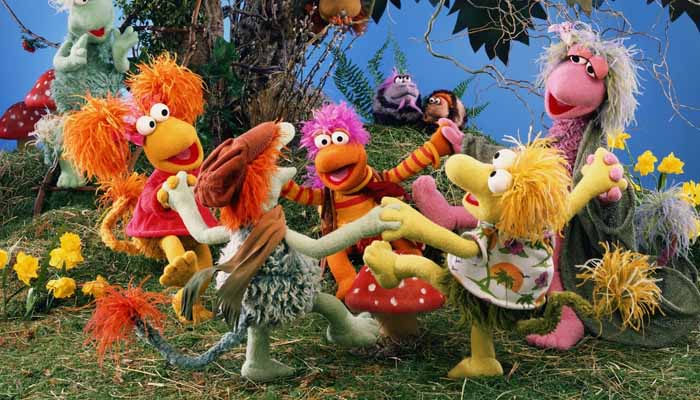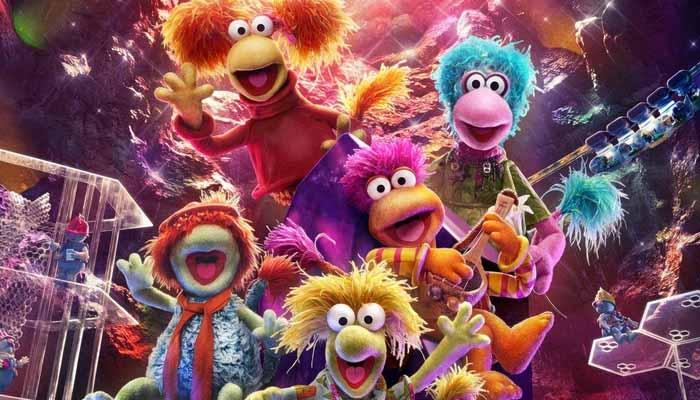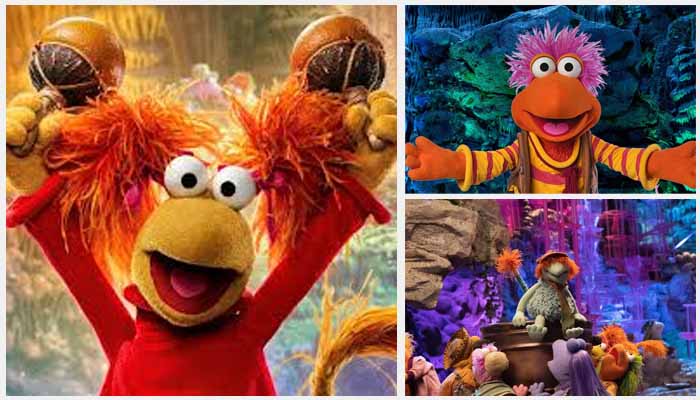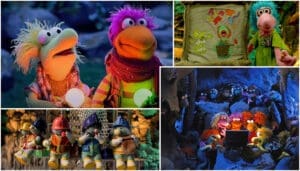Remember the catchy tune, the vibrant colors, and the whimsical world beneath our feet? For many, the words “Fraggle Rock” conjure a wave of nostalgia, a fond recollection of a children’s show that was so much more than just puppets singing songs. Created by the legendary Jim Henson, this series left an indelible mark on television, charming audiences young and old with its unique blend of music, humor, and surprisingly profound life lessons. Let’s delve into the origins, the impact, and the enduring legacy of this beloved show.
The Roots of the Rock: Genesis and Premise
The creative genius behind Fraggle Rock was none other than Jim Henson, a visionary who consistently pushed the boundaries of puppetry and storytelling. Henson, known for his work with the Muppets and Sesame Street, harbored an ambitious goal for Fraggle Rock: to promote “world peace” and “international understanding”. This aspiration wasn’t just a lofty ideal; it was woven into the very fabric of the show. Henson’s prior experience adapting Sesame Street for different international markets likely fueled his desire to create a program with a truly universal message right from its inception. Colleagues even described him as a “gentle anarchist,” suggesting his aim was to inspire positive social change through his imaginative creations.
Fraggle Rock first graced television screens on January 10, 1983, and continued its initial run until March 30, 1987. Over five seasons, viewers were treated to 96 episodes that explored a fantastical world unlike any other. These episodes aired on HBO, a then-fledgling pay television service that was making its first foray into original programming. This early commitment to unique content on HBO highlights the show’s significance in the network’s development.
The heart of Fraggle Rock lies in its simple yet captivating premise: an interconnected ecosystem of Muppet creatures living in a network of caves beneath the human world, affectionately dubbed “Outer Space” by the Fraggles. This subterranean realm was home to three primary species. The Fraggles themselves were carefree and fun-loving creatures who spent their days playing, singing, and exploring. In stark contrast were the Doozers, small, industrious beings dedicated to working and building intricate constructions out of radish-based materials. And then there were the Gorgs, large, furry humanoids who considered themselves the rulers of their land and the owners of the radishes that both Fraggles and Doozers relied upon. Adding another layer to this intricate world was the connection to “Outer Space” through a hole in the wall of a human inventor named Doc (or a lighthouse keeper in the UK, a chef in France, demonstrating the show’s international adaptability) and his dog Sprocket. Gobo Fraggle’s Uncle Traveling Matt, an adventurous explorer, would often venture into the human world, sending back postcards with humorous and often inaccurate observations about the “Silly Creatures” (us humans). Interestingly, the show was initially conceived with the name “Woozle World” before the more memorable “Fraggle Rock” was chosen.
Why We Danced Our Cares Away: Connecting with the Audience

Fraggle Rock was strategically aimed at an audience of “mid-kids,” those who had outgrown the early educational focus of Sesame Street but weren’t quite ready for teenage programming. However, its charm and universal themes allowed it to resonate with a much broader family audience. Henson successfully found a sweet spot between the very young and the adult, offering content that was both entertaining and thought-provoking.
The show’s popularity during its original run stemmed from a potent combination of factors. The music was undeniably infectious, with catchy and memorable songs that had children (and adults) singing along. The characters themselves were instantly lovable, each with distinct and relatable personalities that viewers could connect with. The richly imagined underground world of Fraggle Rock provided a captivating backdrop for their adventures. Beyond the entertainment, the show subtly wove in positive messages about friendship, cooperation, and understanding, imparting valuable life lessons without feeling preachy. And let’s not forget the humor and silliness that permeated every episode, appealing directly to the lighthearted nature of childhood. This clever blend of lighthearted entertainment with deeper substance was a key ingredient in Fraggle Rock’s success, allowing children to enjoy the show on a surface level while simultaneously absorbing important social and emotional lessons, contributing significantly to its lasting impact.
More Than Just Radishes and Songs: Exploring the Show’s Core Themes
Fraggle Rock went beyond simple entertainment, subtly addressing significant themes that remain relevant today. One of the most notable was environmentalism. The show cleverly illustrated the interconnectedness of all living things and the consequences of their actions through the delicate balance between the Fraggles, Doozers, and Gorgs. The Fraggles relied on radishes from the Gorgs, the Doozers used those radishes to build, and the Fraggles, in turn, ate the Doozers’ constructions, creating a unique symbiotic relationship. Marjory the Trash Heap, a wise and sentient compost pile, served as an “oracle” for the Fraggles, embodying the principles of recycling and representing the earth itself. In this way, Fraggle Rock was remarkably forward-thinking, promoting ecological awareness in children’s programming long before it became a mainstream concern. By presenting these concepts through engaging fantasy creatures, the show made complex environmental ideas accessible and memorable for young viewers.
Friendship was another cornerstone of Fraggle Rock. The adventures of Gobo, Red, Mokey, Wembley, and Boober consistently highlighted the importance of camaraderie and working together. The “Friendship Song,” with its recurring message of support and reliance on one another, became a beloved anthem of the show. Despite their individual differences and occasional squabbles, the Fraggles always ultimately supported each other, demonstrating that strong bonds are crucial for navigating life’s ups and downs. The diverse personalities within the Fraggle Five allowed children to witness different approaches to friendship and conflict resolution, fostering empathy and understanding.
Cultural understanding was also a central theme, reflecting Henson’s desire for international harmony. The show frequently depicted the challenges in communication and the misunderstandings that arose between the Fraggles, Doozers, and Gorgs due to their vastly different cultures and biology, even though they were all interdependent. The very fact that the show was an international co-production, with different human segments created for various countries, underscored this commitment to global appeal and cultural relevance. Henson’s intention to foster “international understanding” was so profound that Fraggle Rock became the first American television show to be broadcast in the Soviet Union during the Cold War, a testament to its potential to bridge even significant cultural and political divides.
Beyond these core themes, Fraggle Rock also touched upon issues like prejudice, spirituality (through Marjory the Trash Heap), personal identity, and social conflict. The show’s brilliance lay in its ability to address these complex subjects in a way that was accessible and engaging for children without ever becoming overly didactic. By using allegorical fantasy creatures, Fraggle Rock created a safe and imaginative space for young viewers to explore important aspects of the world around them and their place within it.
Let the Music Play: The Heartbeat of Fraggle Rock

Music was not just an added element in Fraggle Rock; it was the very heartbeat of the show, with original songs featured in every single episode. Unlike other Muppet productions where music served as part of a variety show format or as an educational tool, Fraggle Rock integrated its songs more deeply into the narrative, functioning almost like a musical where characters expressed their emotions and advanced the plot through song. This made the music an essential and organic component of the show’s storytelling.
The musical landscape of Fraggle Rock was incredibly diverse, encompassing a wide range of genres from folk and blues to gospel, country, rock, Latin, and even 1980s pop. This eclectic mix broadened the show’s appeal and exposed young audiences to different musical styles. Among the many memorable tunes, some truly stood out. The iconic theme song, “Down in Fraggle Rock,” is instantly recognizable and evokes immediate nostalgia. Heartfelt ballads like “Let Me Be Your Song” resonated deeply with viewers , while the simple yet powerful “Friendship Song” reinforced the importance of connection. Other notable songs like “Goodbye (Just a Rainbow in the Sky)” and the quirky “The Preachification of Convincing John” further showcased the show’s musical range. The popularity of the music even extended beyond the show itself, with the theme song reaching number 33 on the British charts. The talented duo of Dennis Lee and Philip Balsam were the primary songwriters behind this incredible musical tapestry, with Don Gillis serving as the musical director. Their consistent quality and the sheer volume of original songs (around 190) they created were crucial to the show’s enduring success.
Music in Fraggle Rock served multiple purposes. It was a vehicle for conveying the show’s messages, exploring the characters’ inner feelings, and even driving the narrative forward. The episode “The Day the Music Died” poignantly illustrated the fundamental importance of music to the very existence of Fraggle Rock. The enigmatic character of Cantus the Minstrel often appeared as a guiding figure, using his songs to impart wisdom and encourage the other Fraggles to find their own unique voices. In essence, music in Fraggle Rock was more than just entertainment; it was a vital element of the show’s unique ecosystem and its underlying philosophy about interconnectedness and individual expression.
Meet the Gang: The Endearing Fraggles and Their Friends
The heart and soul of Fraggle Rock resided in its cast of endearing characters, each with their own distinct personalities and quirks. Leading the charge was Gobo, the pragmatic leader and explorer, constantly venturing into the “First Room” of Outer Space to retrieve postcards from his adventurous Uncle Traveling Matt. Gobo’s adventurous spirit and cleverness, though sometimes bordering on conceit, made him a natural leader, and his connection to the human world through his uncle’s postcards provided a relatable element for young viewers. Some interpretations even suggest an overachieving or slightly entitled aspect to his character, adding a layer of complexity to his leadership role.
In contrast to Gobo’s grounded nature was Red, the energetic and fiercely competitive swimmer and Mokey’s roommate. Red’s fun-loving and cheerful disposition, coupled with her athletic prowess, made her a popular character. Her constant rivalry with Gobo provided a dynamic tension within the group. Despite her competitive streak, Red was also shown to be a deeply loyal and friendly Fraggle.
Mokey, the tallest and oldest of the Fraggles, was the artistic and spiritual soul of the group. With her love for poetry, painting, and her pet plant Lanford, Mokey often served as the optimist and the voice of reason, guiding her friends with wisdom and empathy. Her occasional tendency to overextend herself in her desire to help everyone added a relatable human element to her character.
Wembley, Gobo’s best friend, was the nervous and perpetually indecisive member of the Fraggle Five. His cheerful and innocent nature, however, made him incredibly endearing, and his “wembling” – his inability to make up his mind – often provided comedic relief. Wembley’s indecisiveness stemmed from a deep desire to avoid hurting anyone’s feelings, highlighting his inherent kindness and empathy.
Rounding out the main Fraggle group was Boober, the pessimistic, superstitious, and homebody Fraggle who found solace in laundry and cooking. Boober’s anxieties and his comfort in routine made him surprisingly relatable, and his alter ego, Sidebottom, offered both comedic moments and an exploration of inner conflict. His cautious nature often served as a valuable counterpoint to the more impulsive Fraggles, demonstrating the importance of different personality types within a group.
Beyond the main Fraggles, other key characters enriched the world of Fraggle Rock, including the adventurous Uncle Traveling Matt, the wise Marjory the Trash Heap, the industrious Doozers, and the lumbering Gorgs. This diverse cast, each with their unique traits and roles within the interconnected ecosystem, was crucial to the show’s rich world-building and its exploration of interdependence. The contrasting personalities and cultures of these groups provided ample opportunities to explore themes of communication, understanding, and the delicate balance of life.
A Ripple Effect: Fraggle Rock’s Enduring Influence on Children’s TV
Fraggle Rock’s impact extended far beyond its initial run, leaving a significant mark on the landscape of children’s television programming. The show’s innovative approach to addressing complex social issues within a children’s program was groundbreaking. Its central role of music and its integration into storytelling set a new standard. Furthermore, its international co-production model was ahead of its time. Fraggle Rock demonstrated that children’s shows could be both entertaining and deeply meaningful, fostering empathy, understanding, and critical thinking in young viewers. By refusing to talk down to its audience and tackling real-world issues through the lens of allegory, the show raised the bar for quality children’s entertainment. The show’s success likely inspired future creators to consider similar approaches in their own projects, recognizing the viability of high-quality children’s programming that could resonate globally and address significant themes.
Fraggle Rock also utilized innovative production techniques for its time, including the use of green screens and sophisticated animatronics, particularly for the full-body Gorg puppets. The localized human segments created for different international markets were another unique innovation, enhancing the show’s global appeal.
Returning to the Rock: Revivals and Spin-offs

The enduring popularity of Fraggle Rock has led to several revivals and spin-offs over the years. In 1987, an animated series, simply titled Fraggle Rock: The Animated Series, aired for one season. While it maintained the spirit of the original, it didn’t quite capture the same magic or achieve the same level of lasting impact, suggesting that the unique charm and puppetry of the original live-action series were integral to its success.
In 2014, the Fraggle Rock universe expanded with The Doozers, a computer-animated spin-off aimed at a younger preschool audience. This series focused on STEM themes through the adventures of four young Doozers and their building projects. This expansion demonstrated the continued appeal of the core concepts and characters for different age groups.
Most recently, in 2022, Apple TV+ premiered Fraggle Rock: Back to the Rock, a reboot that brought back the beloved original characters alongside some new additions. Featuring guest appearances by celebrities and even a holiday special titled “Night of the Lights,” this revival has been largely praised by critics and audiences for successfully capturing the spirit of the original while updating it for a modern audience. The reboot has also tackled contemporary themes like anxiety, mindfulness, consent, and environmental conservation, proving the show’s continued relevance. The music remains a strong element, and the overall positive reception underscores the timelessness of Fraggle Rock’s themes and characters, demonstrating its ability to resonate with new generations. The enduring legacy of the original series is further cemented by this successful continuation.
Critical Acclaim and Lasting Recognition
The original Fraggle Rock garnered significant critical acclaim throughout its run. It was lauded for its imaginative world, its lovable and relatable characters, and its ability to weave in meaningful messages without being overly didactic. Critics recognized its ambition in addressing social issues in a way that was accessible to children. While Henson’s earlier, darker film The Dark Crystal received a more mixed reception, Fraggle Rock found a stronger and more consistent positive response for its successful blend of entertainment and substance, highlighting Henson’s growth and refinement in creating impactful family entertainment.
Fraggle Rock also received numerous awards and nominations throughout its history, further solidifying its place in television history. These accolades include the prestigious International Emmy Award for Children & Young People in 1983 , as well as multiple Gemini and CableACE Awards. More recently, Fraggle Rock: Back to the Rock has also received significant recognition, including nominations and wins at the Children’s & Family Emmy Awards, PGA Award nominations, GLAAD Media Award nominations, and DGC Craft Awards. The original series even received a TV DVD Award for Best 1980s Series in 2007. This consistent recognition across different eras of the show underscores its enduring quality and its significant contribution to television.
Conclusion
Fraggle Rock was more than just a children’s television show; it was a cultural phenomenon that left an indelible mark on generations of viewers. Created with the ambitious goal of promoting peace and understanding, it achieved this through its imaginative world, its unforgettable characters, and its incredibly catchy music. By tackling important social and environmental themes with sensitivity and humor, Fraggle Rock set a new standard for children’s programming. Its legacy continues to thrive through revivals and spin-offs, proving that the magic of Fraggle Rock is timeless. So, perhaps it’s time to dust off those old memories, revisit the original episodes, or even dive into the new adventures of Gobo and his friends. After all, there’s always a reason to dance your cares away, down at Fraggle Rock.
Original Broadcast Dates
| Season | Episodes | First Released | Last Released |
|---|---|---|---|
| 1 | 24 | January 10, 1983 | July 4, 1983 |
| 2 | 24 | January 2, 1984 | June 11, 1984 |
| 3 | 22 | December 24, 1984 | May 27, 1985 |
| 4 | 13 | January 6, 1986 | March 31, 1986 |
| 5 | 13 | January 5, 1987 | March 30, 1987 |
Main Characters and Their Core Traits
| Character | Performer (Original Series) | Key Personality Traits |
|---|---|---|
| Gobo | Jerry Nelson | Pragmatic leader, explorer, curious, sometimes conceited |
| Red | Karen Prell | Energetic, competitive, fun-loving, athletic |
| Mokey | Kathryn Mullen | Artistic, spiritual, optimistic, contemplative |
| Wembley | Steve Whitmire | Nervous, indecisive, cheerful, kind-hearted |
| Boober | Dave Goelz | Pessimistic, superstitious, enjoys laundry and cooking |
| Uncle Traveling Matt | Dave Goelz | Adventurous explorer of “Outer Space,” often humorous |
| Marjory the Trash Heap | Jerry Nelson | Wise, sentient compost heap, oracle for the Fraggles |




